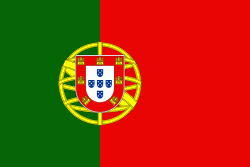São Domingos de Rana (São Domingos de Rana)
São Domingos de Rana is a civil parish (freguesia) of the Portuguese municipality of Cascais, part of the Greater Lisbon subregion. The population in 2011 was 57,502, in an area of 20.36 km². The parish includes the localities Abóboda, Cabeço de Mouro, Caparide, Matarraque, Outeiro de Polima, Polima, Rana, Talaíde, Tires, Trajouce and Zambujal.
The settlement of São Domingos de Rana, is associated with the fertility of the soils and the abundance of spring-waters: the number of archaeological vestiges in the parish implies its place in the settlement of the municipality. In many localities of the parish, human occupation has been almost permanent since the Paleolithic. The archaeological graves in the region attest to agricultural and hunting cultures. This parishes origins date to the settlement of the territory during the Paleolithic to Medieval. The first historical references originated in the Middle Age, one attesting to the existence of locality of Trajouce and the other that mentioned (in 1385) the casal in Freira.
The first census referred, in 1527, referred to all the current localities in the parish. At that time, there was already a parish of São Domingos de Rana, that extended to Albarraque, expanding in 1758 to São Pedro do Estoril. Until 1838, the area was part of the municipality of Oeiras, before integrated into Cascais.
For four decades the territory was exclusively agricultural, cultivating wheat, corn and vegetables, in addition to vineyards. Also, the region was known for the extraction of stone used in the construction. In 1983, professor José d’Encarnação described São Domingos de Rana as an area known of cereal harvests, but was slowly threatened by the growth of the city, and the industrial production of Abóboda. With its accelerated growth, and lack of planning, resulted in the growth of illegal barrios. On 3 March 1976, the Ministérios da Habitação, Urbanismo e Construção and Ministério dos Assuntos Sociais created an interministerial group (the Comissão para o Alojamento de Refugiados - CAR) in order to coordinate and develop solutions for the housing ex-colonial Africans and refugees, then living in emergency housing in Lisbon or along the Algarve. The development of the CAR neighbourhood of Faceiras, in three phases, began on 18 August 1977 with the construction of 81 homes. The following year (resolution 99/78) this program was integrated with other projects by the commission and the Fundo de Fomento da Habitação (FFH) (Housing Development Fund) to sustain the program (17 June 1978).
The settlement of São Domingos de Rana, is associated with the fertility of the soils and the abundance of spring-waters: the number of archaeological vestiges in the parish implies its place in the settlement of the municipality. In many localities of the parish, human occupation has been almost permanent since the Paleolithic. The archaeological graves in the region attest to agricultural and hunting cultures. This parishes origins date to the settlement of the territory during the Paleolithic to Medieval. The first historical references originated in the Middle Age, one attesting to the existence of locality of Trajouce and the other that mentioned (in 1385) the casal in Freira.
The first census referred, in 1527, referred to all the current localities in the parish. At that time, there was already a parish of São Domingos de Rana, that extended to Albarraque, expanding in 1758 to São Pedro do Estoril. Until 1838, the area was part of the municipality of Oeiras, before integrated into Cascais.
For four decades the territory was exclusively agricultural, cultivating wheat, corn and vegetables, in addition to vineyards. Also, the region was known for the extraction of stone used in the construction. In 1983, professor José d’Encarnação described São Domingos de Rana as an area known of cereal harvests, but was slowly threatened by the growth of the city, and the industrial production of Abóboda. With its accelerated growth, and lack of planning, resulted in the growth of illegal barrios. On 3 March 1976, the Ministérios da Habitação, Urbanismo e Construção and Ministério dos Assuntos Sociais created an interministerial group (the Comissão para o Alojamento de Refugiados - CAR) in order to coordinate and develop solutions for the housing ex-colonial Africans and refugees, then living in emergency housing in Lisbon or along the Algarve. The development of the CAR neighbourhood of Faceiras, in three phases, began on 18 August 1977 with the construction of 81 homes. The following year (resolution 99/78) this program was integrated with other projects by the commission and the Fundo de Fomento da Habitação (FFH) (Housing Development Fund) to sustain the program (17 June 1978).
Map - São Domingos de Rana (São Domingos de Rana)
Map
Country - Portugal
 |
 |
| Flag of Portugal | |
One of the oldest countries in Europe, its territory has been continuously settled, invaded and fought over since prehistoric times. The territory was first inhabited by pre-Roman and Celtic peoples who had contact with Phoenicians, ancient Greeks and Carthaginians. It was later ruled by the Romans, followed by the invasions of Germanic peoples and the Islamic invasion by the Moors, whose rule was eventually expelled during the Reconquista. Founded first as a county of the Kingdom of León in 868, gained its independence as the Kingdom of Portugal with the Treaty of Zamora in 1143.
Currency / Language
| ISO | Currency | Symbol | Significant figures |
|---|---|---|---|
| EUR | Euro | € | 2 |
| ISO | Language |
|---|---|
| PT | Portuguese language |















